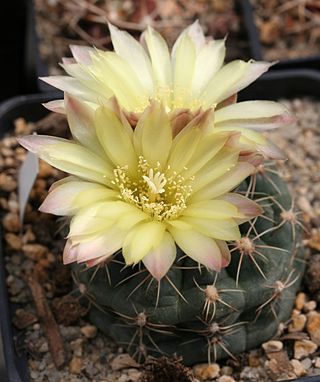
Espostoopsis is a monotypic genus of cactus containing the single species Espostoopsis dybowskii. The generic name is formed from Greek opsis meaning "view", referring to its resemblance to the genus Espostoa, with which it is often confused. The plant is only known from northern Bahia, Brazil.

Quiabentia verticillata is a species of cactus found from Bolivia to Argentina

Facheiroa cephaliomelana is a species of plant in the family Cactaceae.

Micranthocereus albicephalus is a species of plant in the family Cactaceae. It is endemic to Brazil. Its natural habitats are subtropical or tropical dry shrubland and rocky areas. It is threatened by habitat loss.

Micranthocereus streckeri is a species of plant in the family Cactaceae. It is endemic to Brazil. Its natural habitats are subtropical or tropical moist shrubland and rocky areas. It is threatened by habitat loss.

Micranthocereus violaciflorus is a species of plant in the family Cactaceae. It is endemic to Brazil.

Turbinicarpus pseudopectinatus is a species of plant in the family Cactaceae.

Uebelmannia gummifera is a species of plant in the family Cactaceae. It is endemic to Brazil. Its natural habitat is dry savanna. It is threatened by habitat loss.

Cipocereus bradei is a species of cactus. It is endemic to the state of Minas Gerais in Brazil. It is threatened by habitat loss.

Cleistocactus tominensis is a species of columnar cactus in the genus Cleistocactus, endemic to Bolivia, where it is found in forests, on cliffs, and in inter-Andean valleys at altitudes of 900 to 2,200 meters.

Gymnocalycium andreae is a species of Gymnocalycium from Argentina.

Oreocereus trollii, commonly known as the Old Man of the Andes cactus, is a species of cacti native to Argentina and Bolivia. Though listed as Least Concern by the IUCN, the plant is collected extensively, and in some areas is threatened.

Cereus pierre-braunianus is a species of columnar cactus found in NE Goiás in Brazil.

Melocactus ernesti is one of the Turk's cap cacti, and is native to Bahia and Minas Gerais States, Brazil.

Melocactus bahiensis is a species of Melocactus found in Bahia, Brazil.

Cleistocactus buchtienii is a species of columnar cacti in the genus Cleistocactus.

Cipocereus crassisepalus is a species of cactus endemic to the state of Minas Gerais in Brazil.

Brasilicereus phaeacanthus is a species of Brasilicereus found in Brazil.

Micranthocereus estevesii is a species of Micranthocereus found in Brazil.

Micranthocereus purpureus is a species of Micranthocereus found in Brazil.






















